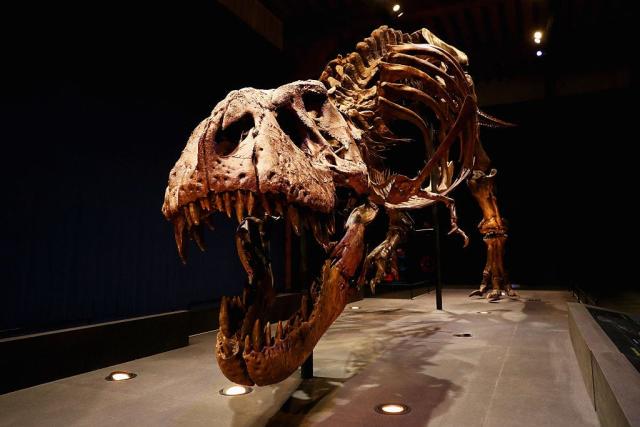Up to 1.7 billion T. rex dinosaurs lived on Earth, a new study found. But scientists aren't sure where all the bones went.

Views (78)

Scientists have uncovered fewer than 100 T. rex fossils, which begs the question: If 1.7 billion lived on Earth, then where are all the bones?
New calculations suggest that 1.7 billion T. rexes lived on Earth from 65.5-68 million years ago.
Scientists have uncovered fewer than 100 fossilized T. rexes, so there may be more to discover.
Only a small fraction of dinosaurs are fossilized because it requires the perfect set of conditions.
So the big question is: Where are all the dino bones?
This dichotomy between how many T. rexes lived and how few fossils we have of them shows us just how rare fossilization is and how much more we have to learn about these majestic creatures.
And scientists have yet to settle on a concrete number.
Marshall and his team created a model factoring in several different variables, including T. rex population density, average body mass index, average life span, geographic range, age of sexual maturity, number of eggs laid, survival rates, and generation time.
In the new study, Griebeler said she "applied a much more realistic survivorship curve" to bring the total number of T. rexes down to 1.7 billion.
"It looks like what she's done is very clever and a significant advance beyond the data that we use in our study," Marshall said. "I've got no complaints. It looks like a better set of survivorship curves than we used."
It's impossible to know for sure exactly how many T. rexes lived during their roughly 2 million years on Earth, but Marshall's model and Griebeler's research provide a reasonable estimate other scientists can build on.
Of the roughly 1.7 billion, or so, T. rexes who roamed our planet, scientists have only uncovered a few hundred fossils, equating to fewer than 100 total dinosaurs.
"If you discover a T-rex tooth during an excavation, that's a big deal for your day or week's work," Stanley said.
Paleontologists are more likely to find fragments of isolated bones, teeth, and claws than a perfectly preserved skeleton of a T. rex or any other dinosaur. And even then, finding any kind of fossil is rare.
That's because the conditions have to be just right for fossilization to occur in the first place.
"Only the smallest fraction of individuals make it to become a fossil, and only a small fraction of those are discovered," Holtz said.
And even if the remains aren't eaten or carried off by other animals, fossilization is also heavily dependent on the environment.
A dinosaur living in the mountains or the open plains, for example, is much less likely to become a fossil because burial is more difficult in those areas than in the lowlands where sediment from the mountains runs off, Holtz said.
"Only individuals that lived and died in the right spots are likely to be covered over by sand or silt or clay and thus possibly preserved," Holtz said.
T. rexes lived in the lowland floodplains with plenty of sediment for burial, which is why scientists actually have more fossils of T. rex and know more about them than many other dinosaurs, Holtz said.
0 Likes
